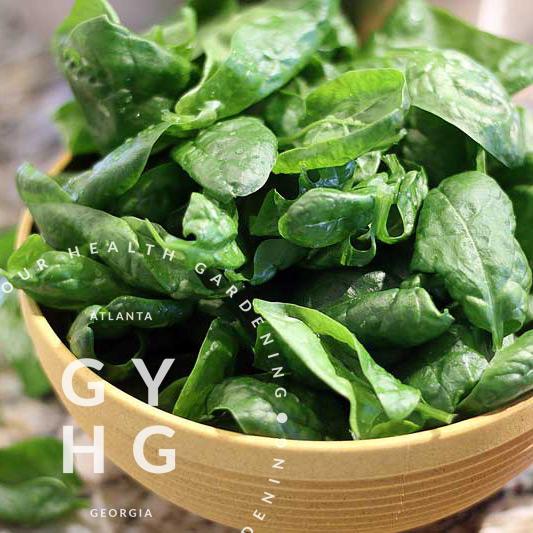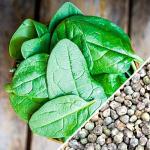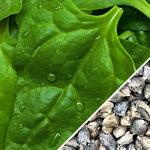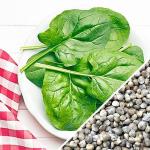Why you should be growing your own spinach instead of buying from the grocery store or big-box retailer:
If you follow EWG’s 2019 Shopper’s Guide to Pesticides in Produce™ report that comes out around March each year, you’ve probably heard that conventionally grown spinach has more pesticide residues by weight than all other produce tested, with three-fourths of samples tested contaminated with a neurotoxic bug killer banned from use on food crops in Europe. It has moved from being ranked 8th on EWG’s “Dirty Dozen” list to number two containing the most pesticides in fruits and vegetables presently being sold in supermarkets and grocery stores around the U.S.. The USDA has also detected pesticides on frozen and canned spinach, which suggests that washing and cooking reduces but does not eliminate pesticide levels. (You can read the full findings on spinach in a press release here.)
Nutritional Profile:
Spinach is a great source of vitamin A, folate and vitamin C. It’s also a good source of vitamin E and potassium. But to receive all these nutritional benefits for your body’s health, it is essential to consume the spinach as quickly as possible post-harvest. Baby spinach leaves have a very high respiration rate and studies have shown that the temp these leaves are stored at plays a key role. For example, A Hort Technology study found that Baby spinach leaves (harvested 36 days after planting) experienced significant loses in nutritional benefit. Both total antioxidant activities and vitamin C content showed a decrease after 6 days when stored at 39.2°F, whereas the total antioxidant activities and vitamin C for leaves stored at 71.6ºF decreased immediately after 2 days. The concentration of magnesium (Mg), zinc (Zn), and iron (Fe) for example, declined after 8 days of storage at 39.2ºF, while at 71.6ºF they declined after 2 days of storage. Total phenolic compounds gradually decreased in samples stored at 39.2ºF whereas, samples stored at 71.6ºF showed a rapid decrease after 4 days. Results demonstrated that quality of baby spinach deteriorates as storage time and temperature increase. (You can read more about the study here.)
Research shows that nutritional benefits degrade with every hour following harvest, so the sooner you can consume your food after it’s been harvested, the more nutrients your body will receive from the spinach.
Degradation happens not only with temperatures, but you also need to factor how long it takes to move the spinach from harvest, transportation, to the product sitting on the shelf to be purchased at the store. It is estimated that it takes about 10-days for produce to be shipped from where it is grown to get to the consumer’s plate. Ten days!!! And you, the consumer are relying heavily on whether or not that spinach was kept at a constant 39.2ºF or lower in the post-harvest process. Essentially, the reason it is cheap at the store is it is an inferior product to what can be grown in your own home.
With a little know-how, you don’t have to eat sub-par spinach and greens. You can grow in your own home and harvest when you’re ready to consume your spinach and greens for optimal nutritional benefit. We are writing this article in mind that our users will be using an aeroponic / hydroponic Tower Garden by JuicePlus+™ indoors or outdoors at home, but the info will also work in related hydroponic systems so long as the environment fits the plant’s needs. You’ll have the self-assurance knowing that your home-grown baby spinach is clean and you can harvest for maximum nutritional benefit when the plant is at it’s peak nutritionally going directly from your Tower Garden to your dinner table in a matter of minutes!
Growing your own spinach:
To grow your spinach, here are some things to keep in mind with what spinach needs to grow successfully. Depending on the time of year and whether you are growing inside or outside are key factors to consider. Spinach is a COOL SEASON crop, so you’ll want to avoid extreme heat which can cause it to bolt (go to seed and become bitter).
Choosing your spinach variety:
When you are starting your spinach from seed, you need to make sure that you have new seed from the previous growing season as older seed has a greater difficulty in germinating. Those varieties that are most suitable for the Tower Garden are recommended as follows:
Spinach: Monnopa Heirloom Low-Acid Spinach Seed (Very Rare)
(100% Heirloom/Non-Hybrid/Non-GMO buy seed buy seed)
– Monnopa Heirloom Low-Acid Spinach Seed is known as one of the sweetest tasting of all spinaches that can have leaves that grow up to 8″ long. This particular variety of spinach is high in vitamin A, C and E and low in oxalic acid — foods low in oxalic acid help to relieve various gastrointestinal symptoms such as heartburn, ulcers and acid reflux disease.
– Extremely delicious and a hard-to-find spinach variety you can grow in your Tower Garden or hydroponic system
– Very easy to grow.
Days to Maturity | 45-60 days
Spinach: Noble Giant
(100% Heirloom/Non-Hybrid/Non-GMO buy seed )
- Noble Giant Spinach is heavy, glossy, dark green plant with leaves that are heavily savoyed and crumpled.
– Extremely delicious and one of the most popular spinach varieties you can grow in your Tower Garden or hydroponic system
– Very easy to grow. - Days to Maturity | 45 days
Spinach: New Zealand
(100% Heirloom/Non-Hybrid/Non-GMO buy seed )
- New Zealand Spinach seeds will produce very flavorful medium triangular-shaped green spinach leaves. New Zealand Spinach is a large growing plant.
- This is one of the few spinach varieties that produces continuously all year, from spring to fall. The more you cut and use the more it will continue to grow.
- And … Unlike the other spinach varieties, the New Zealand is one that can survive through the hot summers.
- Days to Maturity | 75 days
Spinach: Bloomsdale
(100% Heirloom/Non-Hybrid/Non-GMO buy seed )
- Bloomsdale Spinach will produce heavy, glossy, dark green leaves.
– Excellent flavor
– Extremely easy to grow
– Large, curly dark green leaves
– Nice sweet taste - Days to Maturity | 45 days
Spinach: America
(100% Heirloom/Non-Hybrid/Non-GMO buy seed )
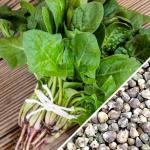
- America Spinach will produce a beautiful dark green plant in only 40 days. Smaller plant stature.
– Excellent flavor.
– Extremely easy to grow.
– Grows best during the cooler months. - Days to Maturity | 40 days
Spinach: Matador Viking
(100% Heirloom/Non-Hybrid/Non-GMO buy seed )
- Matador Viking Spinach will produce beautiful large and smooth dark green spinach leaves in only 45 days.
– Excellent flavor.
– Full of nutrients.
– Extremely easy to grow.
– Grows best during the cooler months.
– Grows really well in containers and other small spaces. - Days to Maturity | 45 days
Spinach: Winter Giant
(100% Heirloom/Non-Hybrid/Non-GMO buy seed )
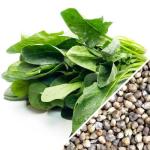
- Winter Giant Spinach seeds will produce very flavorful large green spinach leaves.
- Winter Giant is a variety of Spinach which is a member of the Spinacia family. It is a Vegetable and is treated mainly as a Annual, this means that it grows best over the course of a single year. source: myfolia
- Known for growing to a height of appx. 2 feet.
- Days to Maturity | 55 days
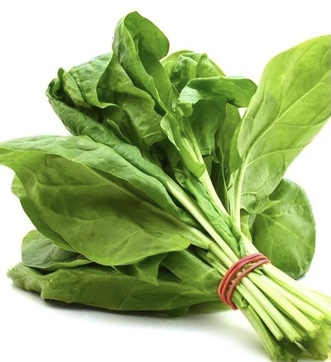
Spinach: Monstruex (Monstrous) de Viroflay
100% Heirloom/Non-Hybrid/Non-GMO buy seed)
- Monstrueux de Viroflay Spinach is a 1866 heirloom variety from France.
- Big leaves grow up to 10-inches long, smooth and deep green in color. Very fast growing plants that can be harvested when smaller.
- Taste profile of this spinach has a mild sweet flavor and succulent texture.
- Day to Full Maturity | 45 days (but you can harvest smaller at around 20 days)
A few more things to consider when selecting your variety…
1. Choose slow-bolting varieties for later spring plantings.
2. Disease resistance is more important for fall crops. Savoyed (curly) leaves are handsome and keep better.
3. New Zealand spinach and Malabar spinach are warm-season greens similar to spinach, but different species.
Common spinach cannot grow in midsummer. (For a summer harvest, try New Zealand Spinach or Malabar Spinach, two similar leafy greens that are more heat tolerant.) — Old Farmer’s Almanac
If you’re later in the season and have missed your seed start date, you can always purchase spinach starts from an area hydroponic grower. We recommend driving to a local grower to pick-up any seedlings vs. shipping (remember shipping containers can be extremely warm or extremely cold which can damage tender young plants.)
And finally, when selecting seed, be sure to buy seed locally whenever possible or from a similar growing zone (and I don’t mean from the local Walmart). You’ll want to know WHERE your seed has been grown. Ask! Many commercial seed providers are just seed brokers and the region the plant was grown in may not match your own and thereby cause frustration for you if you cannot match growing conditions. Seed from your local region will be already adapted and you will see greater success. You can find some seed providers in your area here. Further, according to the Director of the Seed Savor Exchange, 75% of Johnny’s seeds are now grown in China! (listen below)
How many plants should you plant:
It is estimated that you will want 15 plants per person. For a family of four, you will want to plant an entire Tower Garden with one extension for 28 plants and keep two spinach plants per rock wool making for 56 plants total. Staggering your plantings will also help with production through the cool season or indoors.
Starting your spinach from seed:
Cold stratification: 1 to 3 weeks prior to planting some growers will store seeds in the refrigerator. It has the effect of hardening them and may lead to a healthier plant. I have found that starting spinach in the refrigerator works great. Place seed in a tupperware type container between paper towels wetted with water and seal with a lid. Mark start date on lid and estimate 10-14 days for germination. When roots just break through seed casing transplant into rockwool and continue to grow under bright lights. Place into Tower Garden when seedling is about 1-2” tall. Check out this video tutorial.
If you’re planting outdoors, you’ll want to pay attention to your frost and freeze dates in your area. (If planting indoors, you can ignore the next paragraph and skip down to the next paragraph as you can plant spinach year round using the Tower Garden LED Indoor Lights.) You can find these dates doing a google search or here.
Outdoor planting in a hydroponics system: If planting in the spring, you will want to start your seeds indoors or in a greenhouse so that your seedling start will be about four to six weeks old by the time your spring frost date rolls around. If planting in the fall, you’ll want to factor in your harvest date range and count backwards from your frost date. Note: in the fall, you will want to expose your seedlings to UV rays without excessive heat. Spinach likes to live around 45º-75º and may fail to germinate if too warm. For example, in the southeast, you will want to select a variety that has a short maturation date for a fall planting and use a UV light system of some sort to grow your seedlings indoors keeping the light source 8″-12″ if LEDs and 5″-6″ away from seedlings if fluorescent lighting.
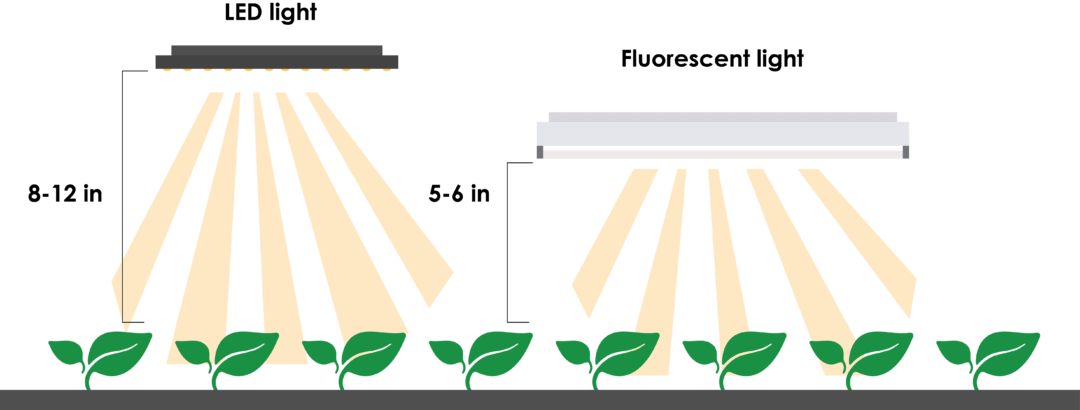
How many seeds to plant per rock wool: We recommend planting about 5 seeds per rock wool cube. Spinach typically germinates within 1–2 weeks. Be sure to use seed that is packaged for the current growing season as it will aide your ability to germinate the seeds.
How much nutrients you should give your seedlings: Water daily with 1/4 strength nutrient solution until the seeds germinate and sprout. After sprouting use 1/2 strength solution.
Thinning out your seedling starts: As the seeds germinate and grow, you will want to pull (or also called “thin out”) the weaker seedlings from the rock wool. (Remember, this is not a wasted plant — you can try to replant in soil or simply enjoy eating it as a microgreen.) You will want to leave leave 1-2 plants per rock wool to mature.
Transplanting your seedlings into your hydroponic system: Seedlings should be ready to transplant to your Tower Garden or hydroponic system about 2–3 weeks after sprouting. Seedlings plants should be about 2-3 inches tall, with 3-4 true leaves, before they are ready to leave the nest and enter into the hydroponic / aeroponic Tower Garden or other related system.
Finally, remember that spinach plantings should be staggered in roughly 2-3 week intervals in order to ensure a continuous harvest. If doing a spring planting, your growing season will be longer than a fall planting. You can extend your fall outdoor planting season by adding a professional grade heater to your Tower Garden reservoir keeping water temps in the 70º F range for the root zone to continue to uptake nutrients.
Nutrient levels for optimal growth throughout the growing season for spinach:
EC: 1.5 mS cm-1 (1.2 for warmer temps)
PPM: 1260-1610
pH: 5.8-6.2
Amount of sun or light exposure throughout the day:
hydroponic spinach should get between 10 and 14 hours of light per day.
Spinach Temp Tips:
Maximum Temp 75º Degrees Fahrenheit
Optimal Day Cycle Temps 65º – 70º Fahrenheit
Optimal Night Cycle Temps 60º – 65º Fahrenheit
Seed Storage 40º to 70º degrees Fahrenheit
Germination 60º to 75º degrees Fahrenheit
Tip: If you’re planning on planting spinach outdoors, do a quick search for your average temps in your area. (Like this) As you’ll see in clicking that link, Atlanta temps in the 65ºF-70ºF range occurs in March. So, if I’m planting Spinach outdoors, I need to begin planting seed 2 weeks prior to March and do a continuous seed start every week to give a continued production as temps begin to warm.
Harvesting your spinach:
Note the days to maturation on the variety of spinach you are planting and mark your calendar. When your plants have reached maturation, take a sanitized clean pair of hand trimmers or scissors and cut the outer older leaves of your spinach plant from the bottom upwards, leaving 3 top center leaves to continue to grow. The plant will continue to produce leaves for you throughout the growing season. Simply return and harvest the outer leaves leaving 3-4 center leaves to continue to produce. Ideally, your spinach should be eaten within a few hours of harvest; however, if storage is necessary, the correct conditions to prolong shelf life are rapid cooling down to 34°F and 95-98 per cent humidity (i.e inside a plastic bag).
How to store spinach that is not consumed right away:
If you have more spinach producing faster than you can eat, there are a couple of options: dehydrating or freezing.
To dehydrate your spinach leaves, place on a dehydrator rack at 110º F for 12-24 hours. When the leaves are crunchy (you can break them in half), remove from the dehydrator and place in a tightly sealed pouch or Mason jar with an oxygen absorber. Dehydrated spinach can be used in soups and ground into a powder to add to pestos for additional nutrients.
You can also freeze your crop in an air-tight bag or container and use in smoothies or defrost and use in recipes that may call for spinach. The benefit here is that a) you know what is on your spinach (no pesticides!) and b) your ability to harvest and process immediately vastly improves nutritional value of the spinach you’re consuming.
Let us know if you have any questions in the comments below. And happy growing!

